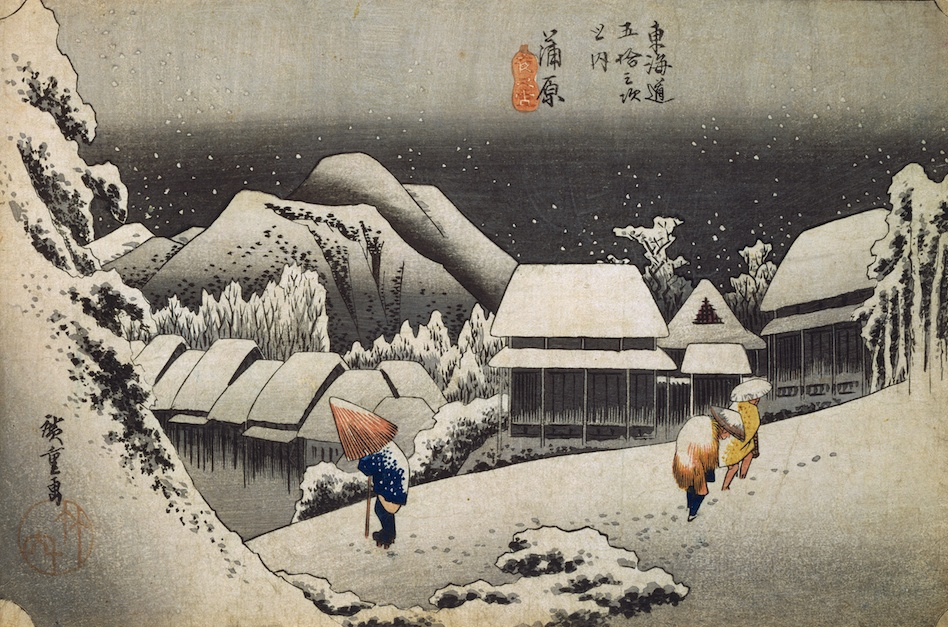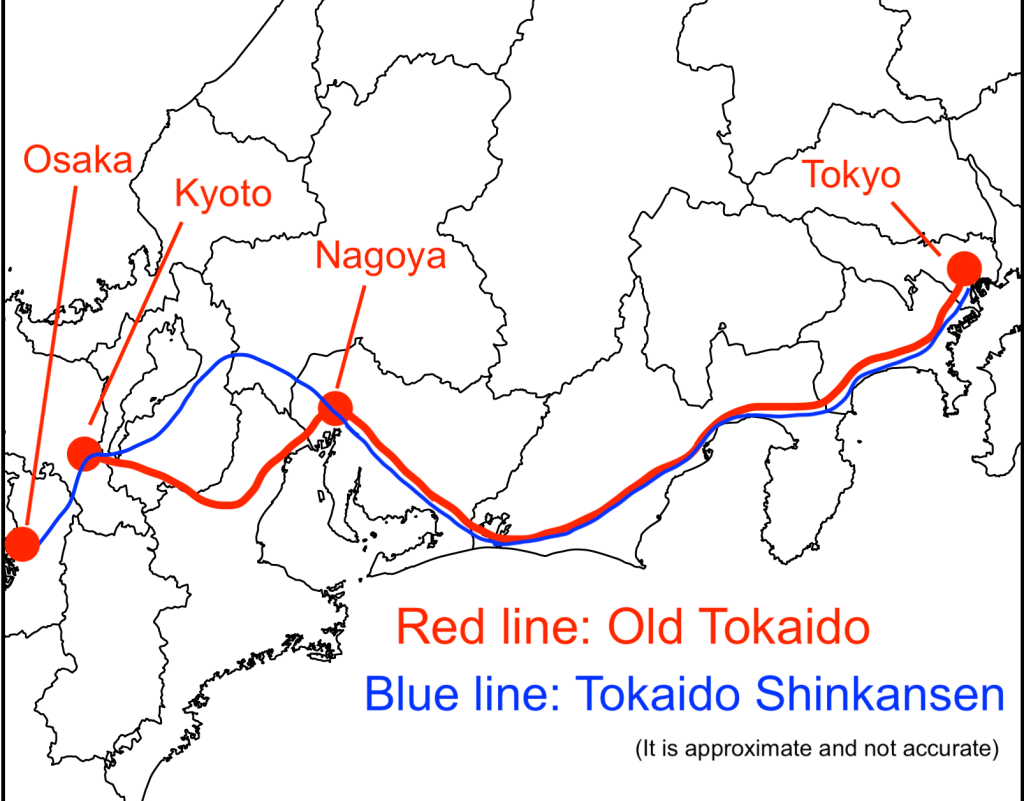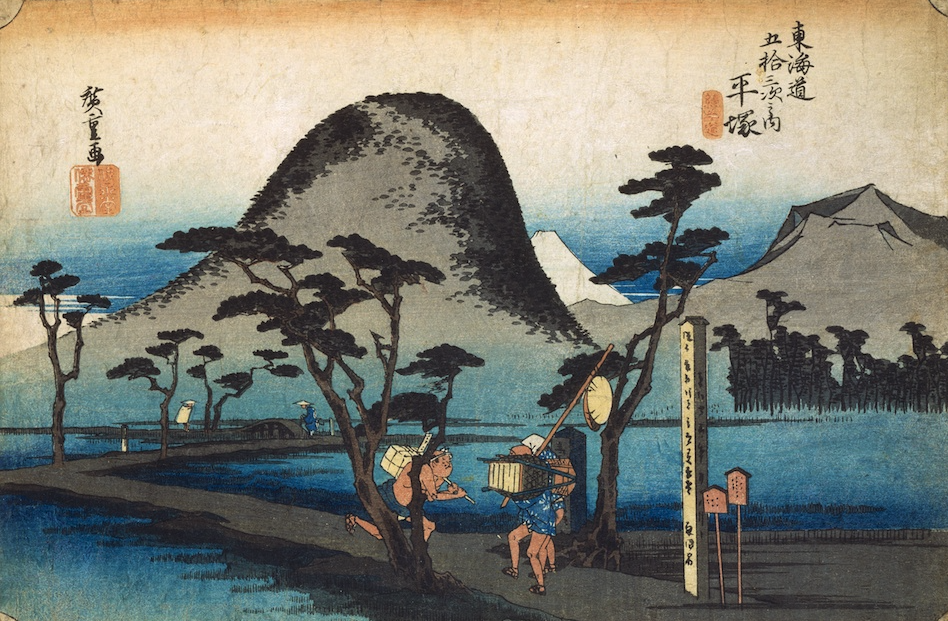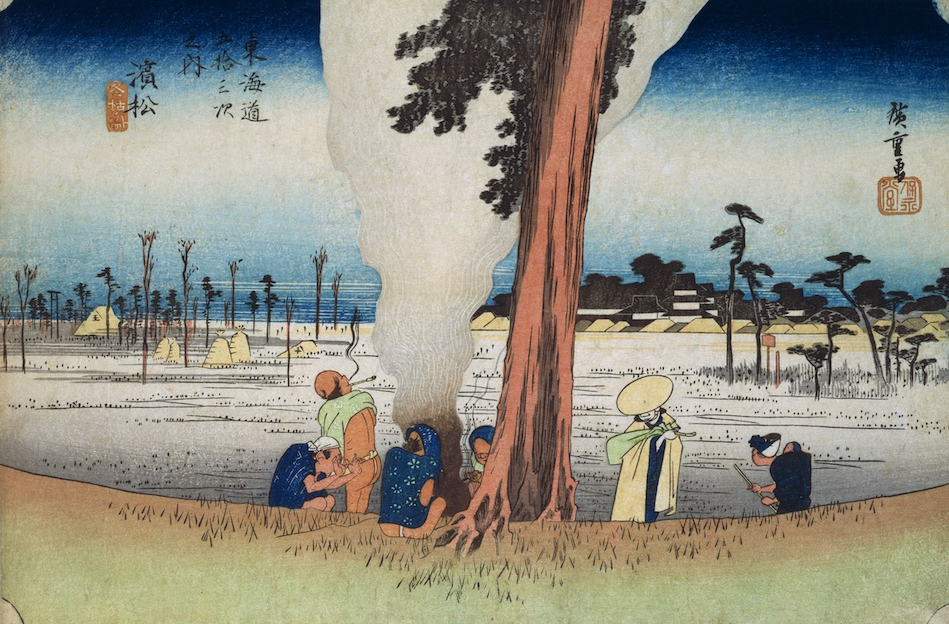Utagawa Hiroshige(歌川広重) was an Ukiyo-e artist of the Edo period (1600-1867) who is also known as “the first master of landscape painting. His representative works include “The Fifty-three Stages of the Tokaido(東海道五拾三次)” and “Famous Places of the Eastern Capital(東都名所)”.
He and Katsushika Hokusai lived at about the same time, and the two artists influenced and absorbed each other’s work in a variety of ways.

Fifty-three Stations on the Tokaido: Night Snow at Kanbara(1833-34/from Tokyo Fuji Art Museum)
A genius painter born into a samurai family
He was born in 1797 in Edo (present-day Tokyo). His father was a samurai and Jobikeshi(定火消), the equivalent of today’s firefighters.
In 1809, when he was 13 years old, his both parents died, and he was forced to take over the firefighting business at a young age, but he did not like it because he always loved painting.
He wanted to join Utagawa Toyokuni(1769-1825), who at that time dominated the Ukiyo-e scene with his Yakusha-e (portrayals of actors) and Bijinga (portraits of beautiful women), but he was not allowed to join because Toyokuni already had many disciples. Therefore, he joined Toyokuni’s school under Utagawa Toyohiro, who was also a member of the Utagawa school. This was when he was 15 years old, and the following year he was allowed to take the name “Hiroshige”.

Fifty-three Stations on the Tokaido: Distant View of Mt. Akiba near Kakegawa
(1833-34/from Tokyo Fuji Art Museum)
SHOP NOW -Hiroshige’s real Ukiyo-e
The work that marked his rise to fame
It was around 1831 that his paintings began to gain popularity, with the publication of “Toto Meisho” (The Famous Places of the Eastern Capital) (series of 10 paintings), known as a masterpiece of early landscape painting. At the time, he called himself Ichiyusai Hiroshige.
The series was well received, and around the following year, he joined the Edo shogunate’s procession to Kyoto. At that time, one of the main roads connecting Tokyo and Kyoto was called “Tokaido”. The tracks of today’s “Tokaido Shinkansen” generally follow this route, and it was, and still is, a major roadway, the main artery of Japan.

Every few kilometers along the way, there was a town called “Shukuba,” where travelers continued their journeys while taking rest stops. The Tokaido way had 53 Shukuba between Tokyo and Kyoto. Even today, many of the large towns along the Tokaido way are former Shukuba towns.
Hiroshige traveled along the Tokaido way to Kyoto and then returned to Edo, and from 1833 he began to publish the landscapes he saw in each of these towns in the “Fifty-three Stations of the Tokaido” (a total of 55 paintings). 53 landscapes were painted, one by one, at each of these Shukuba towns. This series, which took about two years to complete, established him as a landscape painter. He started the heyday of his career with this series.

Fifty-three Stations on the Tokaido: Nawate Road at Hiratsuka
(1833-34/from Tokyo Fuji Art Museum)
SHOP NOW -Hiroshige’s real Ukiyo-e
Japan was in a travel boom
Why did his paintings become so popular? It is deeply related to the “travel boom” in Japan at the time.
At that time, Japan had many customs gates called Seki-sho in various parts of the country, and common people were generally not allowed to travel freely throughout the country. However, people were allowed to travel to Ise Shrine in Mie Prefecture to pay homage (called Ise-mairi or Okage-mairi), and they would stop by Kyoto or Osaka to have fun on their way to Ise.
This Ise pilgrimage became a big boom, and many people began to travel along the Tokaido way and other routes. Taking advantage of this boom, Han-moto (publishers who planned and sold Ukiyo-e works) began to order many landscapes from Ukiyo-e artists.
In the midst of this travel boom, Hiroshige’s “The Fifty-three Stages of the Tokaido” enjoyed explosive sales, and Katsushika Hokusai, 37 years his senior, also published “Thirty-six Views of Mount Fuji(富嶽三十六景)” and other works.
In addition, Hiroshige also published “Eight Views of Omi(近江八景)”, “Eight Suburban Views of Edo(江戸近郊八景)”, “The sixty-three stages of Kisokaido” and “One Hundred Famous Views of Edo(江戸名所百景).

Fifty-three Stations on the Tokaido: Desolate Winter Scene at Hamamatsu(1833-34/from Tokyo Fuji Art Museum)
SHOP NOW -Hiroshige’s real Ukiyo-e
Bold composition and elegance
In his landscapes, we can see the subtlety and softness of his master, Utagawa Toyohiro, as well as the creative composition and expression of Katsushika Hokusai, who was about the same age as his father. On the other hand, we can also sense the elegance and good appearance that comes from being from a family of samurai. Above all, it evokes a sense of nostalgia that invites people to travel. This may be the reason why his works are still highly valued nearly 200 years later.
In his later years, he was commissioned by the Tendo clan in Yamagata Prefecture to create some 200 paintings, which can still be seen today under the name “Tendo Hiroshige”. In addition to these paintings, Hiroshige also left a variety of paintings in the places he traveled. As a great artist, he may have deepened his relationship with the people of each place he visited by painting there while traveling for research.
His Ukiyo-e were later exported to France and other European countries, where Van Gogh and others enthusiastically copied them. The bold compositions and depictions of Hiroshige’s paintings had a great influence not only on the Japanese but also on people overseas.

Fifty-three Stations on the Tokaido: Mie River near Yokkaichi
(1833-34/from Tokyo Fuji Art Museum)

